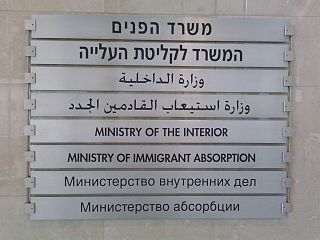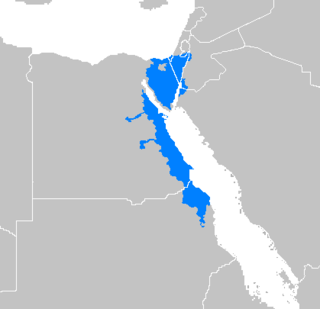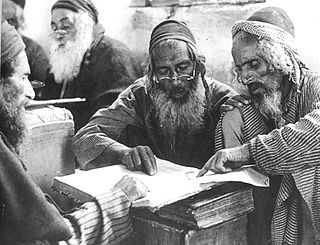 W
WThe Israeli population is linguistically and culturally diverse. Hebrew is the country's official language, and almost the entire population speaks it either as native speakers or proficiently as a second language. Its standard form, known as Modern Hebrew, is the main medium of life in Israel. Arabic is used mainly by Israel's Arab minority which comprises about one-fifth of the population. Arabic has a special status under Israeli law.
 W
WArabic is a Semitic language that first emerged in the 1st to 4th centuries CE. It is now the lingua franca of the Arab world. It is named after the Arabs, a term initially used to describe peoples living in the Arabian Peninsula bounded by eastern Egypt in the west, Mesopotamia in the east, and the Anti-Lebanon mountains and Northern Syria in the north, as perceived by ancient Greek geographers. The ISO assigns language codes to 32 varieties of Arabic, including its standard form, Modern Standard Arabic, also referred to as Literary Arabic, which is modernized Classical Arabic. This distinction exists primarily among Western linguists; Arabic speakers themselves generally do not distinguish between Modern Standard Arabic and Classical Arabic, but rather refer to both as al-ʿarabiyyatu l-fuṣḥā or simply al-fuṣḥā (اَلْفُصْحَىٰ). Modern Standard Arabic is an official language of 26 states and 1 disputed territory, the third most after English and French.
 W
WThe Arabic language in Israel is spoken natively by a large proportion of the population, reaching over 20 percent of the total population, mainly by the Arab citizens of Israel and among the Arabic-speaking Jews from the Arab world. Some refer to the modern Hebrew-influenced Levantine Arabic vernacular as the Israeli Arabic dialect.
 W
WHebrew is a Northwest Semitic language of the Afroasiatic language family. Historically, it is regarded as the spoken language of the Israelites and of their longest surviving descendants, the Judeans and Samaritans, being preserved as the main language used in religious context in post-Temple Judaism and in Samaritanism. It is the only Canaanite language still spoken and the only truly successful example of a revived dead language, and one of only two Northwest Semitic languages still spoken, the other being Aramaic.
 W
WJudaeo-Spanish or Judeo-Spanish, also known as Ladino, is a Romance language derived from Old Spanish. Originally spoken in Spain, and then after the Edict of Expulsion spreading through the then-Ottoman Empire as well as France, Italy, the Netherlands, Morocco and England, it is today spoken mainly by Sephardic minorities in more than 30 countries, with most of the surviving speakers residing in Israel. Although it has no official status in any country, it has been acknowledged as a minority language in Bosnia and Herzegovina, Israel, France, and Turkey. In 2017, it was formally recognised by the Royal Spanish Academy.
 W
WThe Kurdish languages constitute a dialect continuum, belonging to the Iranian language family, spoken by Kurds in the geo-cultural region of Kurdistan and the Kurdish diaspora. The three Kurdish languages are Northern Kurdish, Central Kurdish, and Southern Kurdish.
 W
WLevantine Arabic, also called Shami, or simply Levantine, is a subgroup of mutually intelligible vernacular Arabic varieties spoken in the Levant, in Syria, Lebanon, Jordan, Palestine, Israel, and Turkey. It is also spoken among diaspora communities from this region, most significantly among the Palestinian, Lebanese, and Syrian diasporas.
 W
WModern Hebrew, also known as Israeli Hebrew or Israeli, and generally referred to by speakers simply as Hebrew, is the standard form of the Hebrew language spoken today. Spoken in ancient times, Ancient Hebrew, a member of the Canaanite branch of the Semitic language family, was supplanted as the Jewish vernacular by the western dialect of Aramaic beginning in the third century BCE, though it continued to be used as a liturgical and literary language. It was revived as a spoken language in the 19th and 20th centuries and is the official language of Israel. Of the Canaanite languages, Modern Hebrew is the only language spoken today.
 W
WNorthwest Arabian Arabic is a proposed subfamily of Arabic encompassing the traditional dialects of the Sinai Peninsula, the Eastern Desert, the Negev, southern Jordan, and the northwestern corner of Saudi Arabia.
 W
WThe Russian language is spoken natively by a large proportion of the population of Israel, reaching about 20 percent of the total population by 1989, mostly by immigrants who came from the former Soviet Union in the early 1990s and later years. It is a major foreign language in the country, and is used in many aspects of life. Russian is the predominate non-official native language in Israel. The government and businesses often provide information in Russian, and it is semi-official in some areas with high concentration of Russian Jewish immigrants. The Russian-speaking population of Israel is the world's third-largest population of Russian native-speakers living outside the former Soviet Union territories after Germany and the United States, and the highest as a proportion of the population. As of 2013, 1,231,003 residents of the Post-Soviet states have immigrated to Israel since the fall of the Soviet Union. As of 2017, there are up to 1.5 million Russian-speaking Israelis out of total population of 8,700,000 (17.25%).
 W
WSouth Levantine, a subdivision of Levantine Arabic, is spoken in the Southern Levant, in areas such as the Palestinian Territories, Israel as well as in most of Jordan. It is also spoken in Southern Syria, particularly in the Hauran region of Daraa Governorate.
 W
WYemenite Hebrew, also referred to as Temani Hebrew, is the pronunciation system for Hebrew traditionally used by Yemenite Jews. Yemenite Jews brought their language to Israel through immigration. Their first organized immigration to the region began in 1882.
 W
WYiddish is a West Germanic language historically spoken by Ashkenazi Jews. It originated during the 9th century in Central Europe, providing the nascent Ashkenazi community with a High German-based vernacular fused with many elements taken from Hebrew and to some extent Aramaic; most varieties also have substantial influence from Slavic languages, and the vocabulary contains traces of influence from Romance languages. Yiddish writing uses the Hebrew alphabet. In the 1990s, there were around 1.5–2 million speakers of Yiddish, mostly Hasidic and Haredi Jews. In 2012, the Center for Applied Linguistics estimated the number of speakers to have had a worldwide peak at 11 million, with the number of speakers in the United States and Canada then totaling 150,000. An estimate from Rutgers University gives 250,000 American speakers, 250,000 Israeli speakers, and 100,000 in the rest of the world.